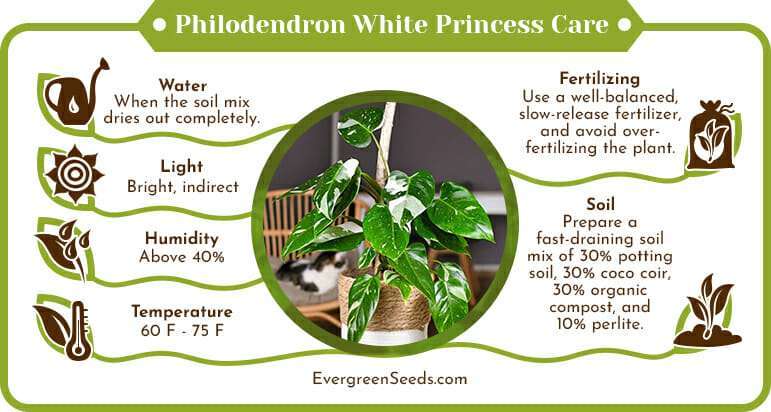 Philodendron White Princess of the Araceae family is a low-maintenance plant that makes it perfect for new gardeners. Its variegated leaves are the highlight and attract the attention of most people.
Philodendron White Princess of the Araceae family is a low-maintenance plant that makes it perfect for new gardeners. Its variegated leaves are the highlight and attract the attention of most people.
If you are interested in buying this philodendron genus plant, you will find all the tips to grow and care for this stunning variegated plant here.
JUMP TO TOPIC
Philodendron White Princess Care
Philodendron White Princess is a maintenance-free plant if you follow its basic growth requirements. Watch the signals that your plant gives and understand what it needs.
Read below all the basic growth requirements needed by your plant to thrive.
 Light
Light
Philodendron White Princess flourishes under bright, indirect light. However, you should keep it away from direct sunlight, especially during noon. Morning and evening sunlight works fine but harsh sunlight can cause leaf burns and may even kill the plant. Moreover, if you notice the leaves going yellow and pale, it is probably because the plant is getting too much light.
Another problem that the plant may face is a lack of light. When the plant does not receive adequate light for growth, it becomes long and leggy. You will not see many new leaves unfurling due to a lack of light. To treat this problem of stunted growth, place your plant close to a window where the plant can receive curtain-filtered sunlight.
 Water Requirements
Water Requirements
Water Philodendron White Princess only when the soil mix dries out completely. Avoid overwatering as it is one of the major causes of diseases and other issues. It does not get thirsty too often. In a humid environment with moderate temperatures, watering twice a week in summers and once a week in winters works well for the plant’s growth.
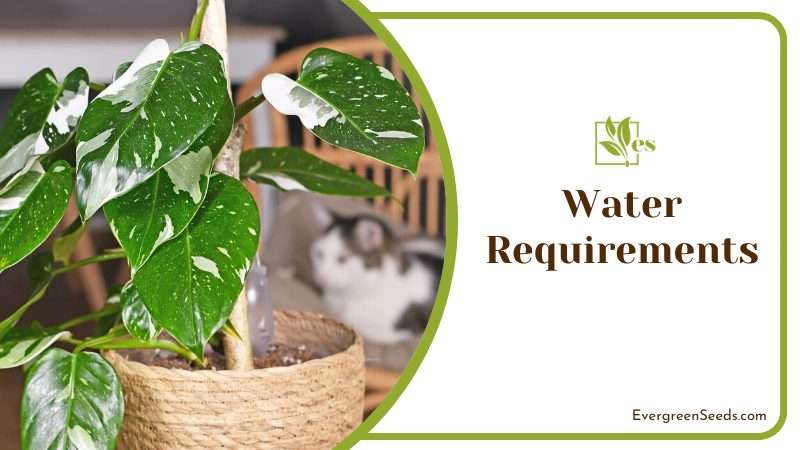
Keep in mind though, that the above-mentioned watering frequency is not a rule. The watering frequency will depend on various other factors in your area. For example, if you notice the leaves of your plant drooping and the soil is dry to touch, it needs water. Then, you should water it thoroughly and allow the water to drain out completely.
Too little water can also cause your plant’s leaves to droop and fall off. If you notice the browning of leaves, increase the watering frequency. Since the plant is not drought-resistant, keep the watering frequency regular according to the prevailing factors in your area.
 Soil Mix
Soil Mix
Philodendron White Princess soil quality can be a make-or-break factor in its growth. Loose and fertile soil can help the plant reach great heights in a matter of a few years. If you do not use a rich soil medium, however, the plant may show stunted growth. In worst cases, it may even die.
Prepare a fast-draining soil mix for Philodendron White Princess to make it grow well. 30 percent potting soil, 30 percent coco coir, 30 percent organic compost, and 10 percent perlite make a rich and airy soil medium and will do the trick for promoting its growth.
Moreover, adding perlite is optional but it does help in making the soil mix airy. In general, keep in mind that the plant likes its soil moist but not soggy.
If you live in a dry area, add more coco coir and less sand to retain moisture in the soil for longer periods, but if you live in a tropical environment, you can avoid adding coco coir. Finally, if you add more perlite and sand, that will help avoid root rot and other fungal diseases.
 Temperature
Temperature
Philodendron White Princess grows well in temperatures ranging between 60 and 75 degrees Fahrenheit. The plant can tolerate slightly warmer and cooler temperatures, but if you keep the plant out of this temperature range for longer periods, it will show stunted growth.
The White Princess Philodendron is a tropical plant that needs warm and humid conditions to grow well, so you should avoid keeping it outdoors in cooler temperatures, especially in frost. If the plant stays in frost for longer periods, the leaves will droop and turn pale and the frost may even kill the plant.
Another extreme condition to avoid is keeping your plant in very high temperatures. Hot temperatures cause yellowing and browning of the leaves, so if you live in a hot area, regulate the temperature around the plant by misting it regularly. Keep the plant in a north or north-east facing window away from direct sunlight.
 Humidity Requirements
Humidity Requirements
Philodendron White Princess is not a drought-resistant plant. Hence, you should place your plant in a humid environment where the humidity levels are above 40 percent. Moreover, maintain medium to high humidity by keeping humidifiers and humidity trays near the plant. Just as for all Philodendrons, try to sustain humidity levels in the range of 40 to 80 percent.
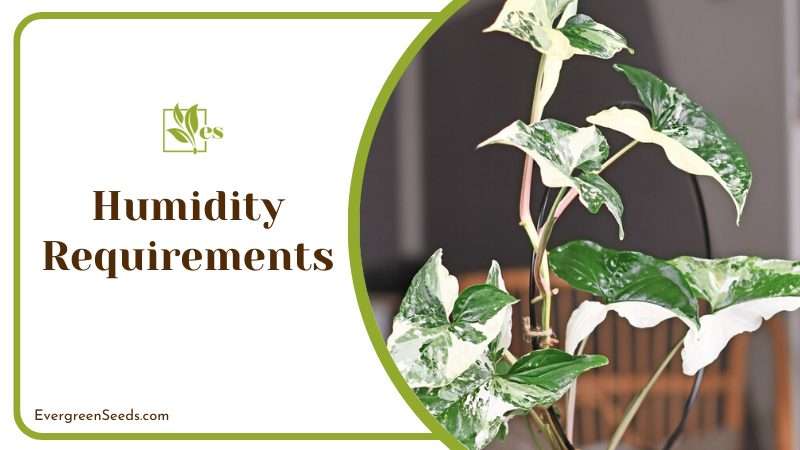
Typically, homes have about 30 to 35 percent humidity. Sometimes, the air is drier in our homes, especially during the winter months, and it becomes a little difficult for these tropical plants to grow well. So this lack of humidity invites unwanted pests such as spider mites that feed on the plants in dry conditions.
You can follow various ways to increase humidity levels and misting is the easiest way to do that. It also helps in regulating temperatures in hot summers. You can also place a humidifier or a humidity tray to increase humidity.
To prepare a humidity tray, fill a tray with some pebbles and water and place your pot on top of it. As the water evaporates, the leaves will absorb the moisture.
If nothing seems to work out for your plant and if your bathroom receives bright, indirect light during the day, move your plant there. Increased humidity in the bathroom will allow the plant to benefit from it.
 Fertilizer
Fertilizer
Fertilize Philodendron White Princess monthly in the spring and summer months and six to eight weeks in fall and winter. Regular fertilization will help keep your plant healthy, yet you should reduce the frequency in the winter months because the plant growth slows down naturally when the temperature falls.
Furthermore, slow growth and smaller leaf formations indicate that your plant is deficient in magnesium and calcium. So you should provide the necessary micro-nutrients by using a well-balanced, slow-release fertilizer, and avoid over-fertilizing the plant as it causes salt build-up.
Salt accumulation can cause root burn. To avoid root burn, you should drain the plant with water every month. Moreover, you shouldn’t fertilize when the soil is dry, so your best bet is to moisten the soil slightly and then add fertilizer.
The frequency of fertilization will also depend on the area you live in. If it stays warm and humid throughout the year, fertilize your plant monthly and don’t hold back in the winter months.
Moreover, while in temperate and sub-tropical areas, fertilize the plant regularly in the active growing season and reduce in the winter months.
Repotting
Repot the plant every two years when it has outgrown the existing pot. If you notice the roots coming out from the drainage holes at the bottom, it is time to shift it to a bigger pot. Spring is the ideal time to shift the plant as the pleasant temperatures in spring give the plant enough time to adjust to the new surroundings.
When repotting, you should choose a new container or pot that is at least two to three inches larger than the last one. The fresh soil and new space will help the roots to grow properly so, instead of using the old soil mix, prepare and add some new soil mix with organic compost to the new pot.
Using a new soil medium will help keep the soil fertile and will give more nutrition to the roots. Moreover, you should also add coco coir for moisture retention and perlite for drainage.
Then, don’t forget to remove the dead roots from the plant and then place the plant in the new soil mix. Also, remember to cover the roots properly and firm the soil around them as well.
After that, you should water the plant thoroughly and keep it in a bright, shaded spot. Make sure to keep two inches gap between the pot’s rim and the soil. Do not fill the soil till the top of the pot, because a couple of inches of space helps in watering.
Propagation
Propagate Philodendron White Princess by taking stem cuttings with at least one to two nodes. First, you should remove the leaves from the bottom of the cuttings. Only keep the top one to two leaves attached to the cutting.
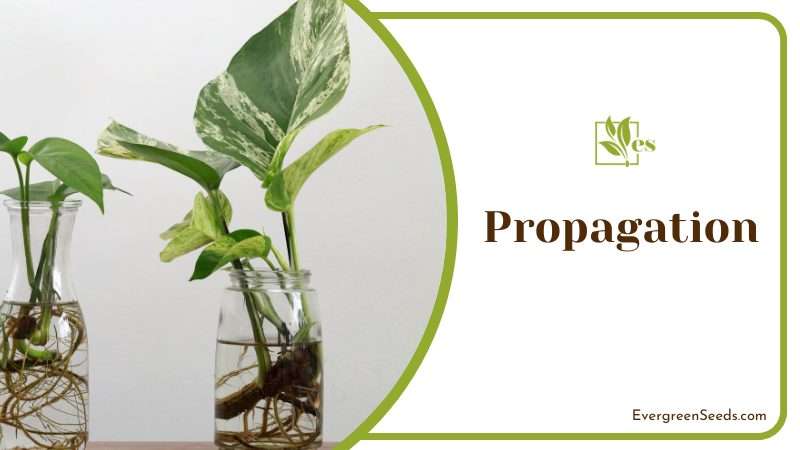
Then, put the cuttings in moist sphagnum moss and keep them in a bright spot, as you wait for the roots to form in their new space. This may take four to six weeks. So, once the roots are about an inch long, shift the plant to a pot in a rich and airy soil mix.
Water the cuttings thoroughly to keep the roots in a moist but not soggy soil mix. Keep the newly potted plant in a bright spot away from direct sunlight. Never let the soil go completely dry.
Additionally, you can also propagate the cuttings in water instead of sphagnum moss. In any case, avoid propagating the plant in the winter months as it will take a long time for it to form roots.
Problems
The most common problems faced by the Philodendron White Princess are diseases and pests. If you spot them early, you can treat them without much difficulty. Let us discuss these in detail below.
– Aphids
Harmful pests such as aphids and mealybugs can pose a problem for your Philodendron if you do not spot them early. If you notice your plant with stunted growth and distorted and yellow leaves, there might be an aphid infestation.
Aphids are tiny, green-colored pests, and they reproduce quickly and leave behind a sticky substance called honeydew. Treat the problem by preparing a homemade soap water solution or a bug control solution.
– Mealybugs
Mealybugs are the other pests that can attack the leaves and stems of your plant. If you notice white, oval, fuzzy spots on the foliage and stems, the Philodendron White Princess is probably infected by mealybugs.
Mealybugs suck the sap from the leaves and cause yellowing, curling, and dehydration in the leaves. So, you can treat the infected part by applying neem oil, rubbing alcohol solution, or by using insecticidal soap.
– Problems due to Overwatering
Root rot due to overwatering is one of the most common problems that many inexperienced gardeners face while growing the White Princess Philodendron. Too much moisture around the plant’s roots causes the roots to suffocate.
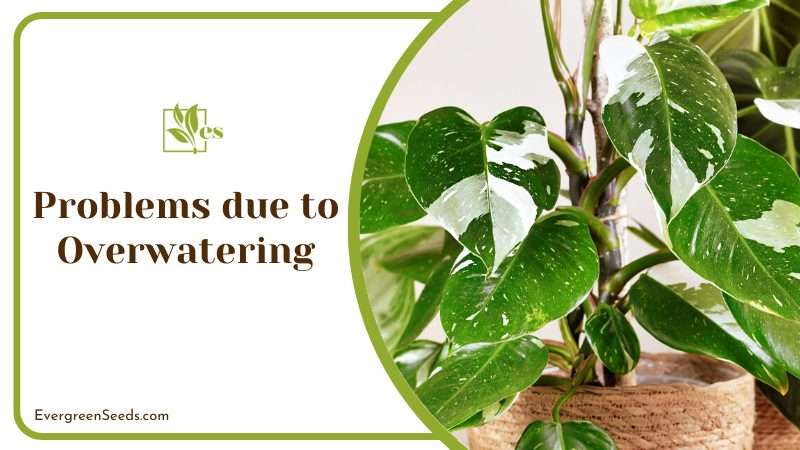
Hence, due to a lesser supply of oxygen, the plant goes catches fungal infections and other dangerous diseases. Prevent this problem by using an airy soil mix that drains water out quickly.
You can check out the following philodendron varieties: philodendron silver stripe, philodendron shangri la, philodendron ring of fire, philodendron jose buono, and philodendron spiritus sancti.












